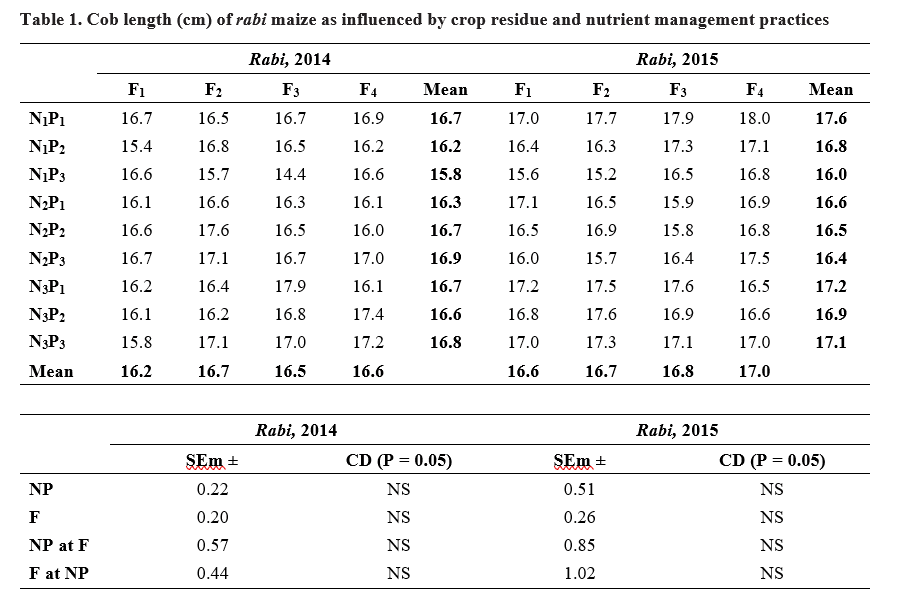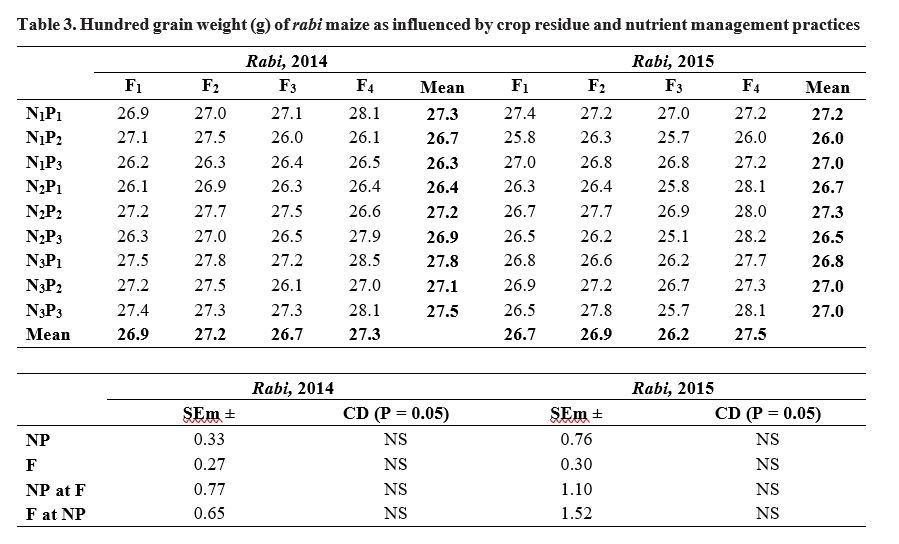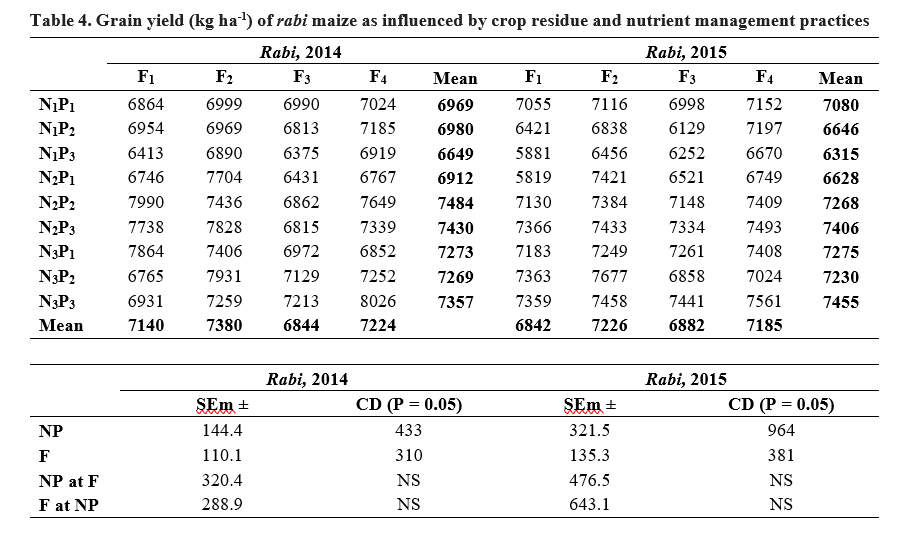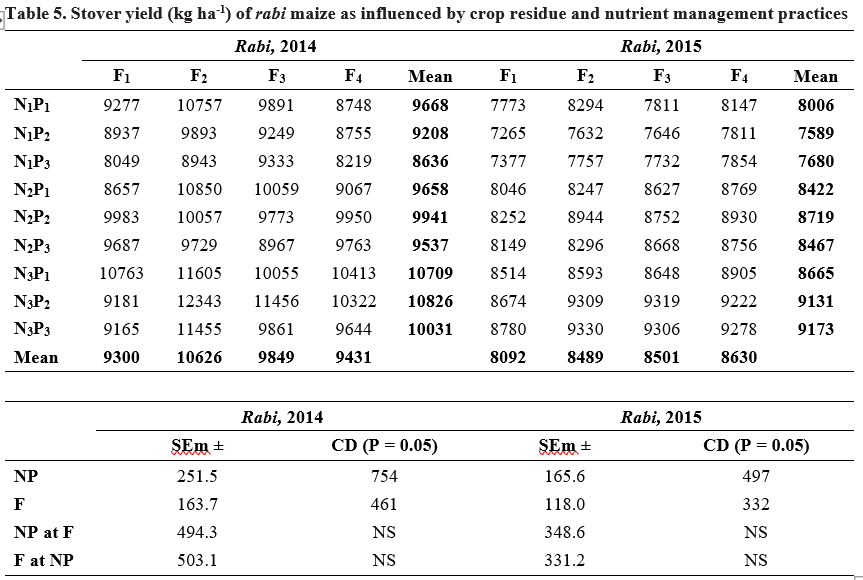Yield Attributes and Yield of Maize (Zea Mays L.) As Influenced by Crop Residues and Nutrient Management Practices
0 Views
VIJAYA BHASKAR REDDY UPPALURU*, PRABHAKARA REDDY GADDAM, SRINIVASA REDDY MALLU AND P. KAVITHA
Department of Agronomy, Sugarcane Research Station, Vuyyuru
ABSTRACT
During rabi, 2014 and 2015 at Agricultural College, Mahanandi the yield attributes viz., number of cobs plant-1, cob length
and hundred grain weight of maize were not influenced significantly due to residual nutrients, nutrient doses ± crop residues and their interaction except number of grains cob-1. Graded levels of nitrogen exerted favorable influence on grain yield of maize. In the present study, the highest yield was obtained with the application of 250 kg and 300 kg N ha-1 in the previous season but the response to P levels was marginal. Significantly higher grain yield was recorded with F2 (125% of F1) which was however on par with F4 (F2 + Kharif crop residue incorporation) in both the years.
KEYWORDS: Crop residue, Yield attributes, Cobs, Grain yield and Stover yield.
INTRODUCTION
Maize (Zea mays L.) is an important cereal food crop cultivated both in tropical and temperate regions of the world with the highest production and productivity as compared to rice and wheat. In the world, maize is cultivated in an area of 146 million hectares with a production of 685 million tonnes and an average productivity of 4.7 t ha-1. It is the third most important cereal after rice and wheat for human food by contributing to 9 per cent of India’s food basket and 5 per cent to World’s dietary energy supply (Saikumar et al., 2012). India is the sixth largest producer of maize with 22.36 million tonnes of production from 9.40 million hectares, with a productivity of 2.4 t ha-1. In Andhra Pradesh, it is cultivated in an area of 0.23 million hectares with a production of 1.41 million tonnes and productivity of 6.1 t ha-1 (ASG, 2016).
The demand for maize owing to burgeoning growth rate of poultry, livestock, fish and wet and dry milling industries is expected to increase from current level of 22.36 million tonnes to 45 million tonnes by 2030 (DMR, 2011). To meet the growing demand, enhancement of maize yield in coming years across all the growing locations in India is the big challenge. Maize is a heavy feeder of nutrients, especially nitrogen and phosphorus, the deficiency of which limits the growth, yield and quality of the crop. In order to meet such challenges, over dependence on chemical fertilizers alone would lead to gradual decline in organic matter content and native fertility status of the soil, which inturn reflects on the future productivity. In addition, due to recent escalation in prices of nitrogenous and phosphatic fertilizers, maize growers are facing crisis in purchase of the above fertilizers. On the other hand, organic manures need to be applied in bulk to meet the heavy nutrient requirement of hybrid maize for improving the fertility status of the soil on sustained manner, which is also not possible due to the scarcity of organic manures. Hence, a strategy of integrated use of nitrogen and phosphorus fertilizers in combination with any amount of cheaper organic source like previous crop residue, which is abundantly available locally should be tried to satisfy the crop requirement to produce higher yield, without impairing soil health. The application of organic residue (e.g., straw) to soils represents a valuable recycling strategy (Cayuela et al., 2009), which reduces in part our dependence on mineral fertilizers. Hence, the present study was under taken to examine the degree to which preceding maize can contribute to the succeeding maize and the appropriate fertilizer schedule.
MATERIAL AND METHODS
The field experiment was conducted at College Farm of Agricultural College, Mahanandi campus of Acharya N. G. Ranga Agricultural University, situated at 15.51°N latitude, 78.61°E longitude and at an altitude of 233.5 m above the mean sea level, in the scarce rainfall
zone of Andhra Pradesh. A composite soil sample was collected at random from 0-30 cm soil depth and analyzed for physico-chemical properties prior to start of the experiments. The soil was sandy loam in texture, neutral in reaction, low in organic carbon and available nitrogen (275 kg ha-1), high in available phosphorus (153 kg ha-1) and potassium (670 kg ha-1) The experiment was conducted in the same plots of kharif season and was laid out in a split-plot design with three replications.
Treatments
There were nine main plots consisting of three nitrogen levels and three phosphorus levels of kharif season and four sub plots comprising of fertilizer and crop residue management practices.
Main plot treatments
Nine main plots (residual nutrients) consisting combination of three nitrogen levels 200, 250 and 300 kg N ha-1 (N1, N2 and N3 respectively) and three phosphorus levels 40, 60 and 80 kg P2O5 ha-1 (P1, P2 and P3 respectively) of kharif season.
Sub plot treatments
Four sub plots (nutrient doses ± crop residues) comprising of fertilizer and crop residue management practices. F1 : Recommended dose of N and P2O5 (250 kg N and 80 kg P2O5 ha-1) , , F2 : 125% of F1, F3 : F1+ Kharif crop residue incorporation and F4 : F2+ Kharif crop residue incorporation. A common dose of 60 kg K2O ha-1 was applied to all the plots.
The crop was sown at a spacing of 75 cm × 15 cm. The test cultivar was P-3396 a single cross hybrid with the yield potential ranging from 7.5 to 8.0 t ha-1. After harvest of the economic produce of kharif maize the stover was allowed to dry in the field itself and plot wise weight of the crop residue was recorded.
Length of the cob from blunt end to shank tip of cobs harvested from five tagged plants was measured and the average of each treatment was expressed as cob length in cm. Total number of grains cob-1 from cobs harvested from five tagged plants was counted and the mean value was presented as number of grains cob-1. Hundred grains randomly drawn from the composite sample of grain yield of net plot of each treatment were weighed and expressed in g. Grain from net plot was sun dried sufficiently, cleaned thoroughly, weighed and expressed in kg ha-1. Stover obtained from net plot was thoroughly sun dried to a constant weight and expressed in kg ha-1.
RESULTS AND DISCUSSION
Number of cobs plant-1
Residual nutrients (main plots), nutrient doses ± crop residues (sub plots) and their interaction did not affect the number of cobs plant-1 during both the years. All the main and sub plot treatments recorded one cob plant-1 and without having any significant interaction during both the years.
Cob length
Crop sown in N2P3 (250 kg N + 80 kg P2O5 ha-1) main plot in the first year and N3P1 (300 kg N + 40 kg P2O5 ha-1) in the second year resulted in higher cob length which was however on par with all the remaining main plots during both the years. With regard to sub plots, higher cob length was recorded with F2 (125% of F1) in the first year and F4 (F2+ Kharif crop residue incorporation) in the second year, which was statistically on par with the remaining sub plots.
Number of grains cob-1
Numbers of grains per cob were significantly affected by residual nutrients (main plots), nutrient doses ± crop residues (sub plots), but the interaction was not significant during both the years. Crop sown in N3P3 (300 kg N + 80 kg P2O5 ha-1) main plot in the first year and N2P2 (250 kg N + 60 kg P2O5 ha-1) in the second year resulted in significantly more number of grains cob-1, which were however on par with all the remaining main plots except with N1P2 (200 kg N + 60 kg P2O5 ha-1) and N1P3 (200 kg N + 80 kg P2O5 ha-1) during both the years.
With regard to sub plots more number of grains cob-1 were recorded with F2 (125% of F1) in both the years, which were statistically on par with F1 (Recommended dose of N and P2O5) and F4 (F2+ Kharif crop residue incorporation) during the first year and with F3 (F1+ Kharif crop residue incorporation) and F4 (F2+ Kharif crop residue incorporation) during the second year.
Hundred grain weight
Crop sown in N3P1 (300 kg N + 40 kg P2O5 ha-1) main plot in the first year and N2P2 (250 kg N + 60 kg P2O5 ha-1) in the second year resulted more hundred grain weight, which were however on par with all the remaining main plots during both the years. With regard

to sub plots, more hundred grain weight was recorded with F4 (F2+ Kharif crop residue incorporation) in both the years, which were statistically on par with the remaining sub plots.
In the present study the different yield attributing characters viz., number of cobs per plant, cob length and hundred grain weight were not influenced by the residual nitrogen and phosphorus levels as well as crop residues. Whereas number of grains per cob were significantly influenced by residual nutrients. Similar observations on the yield attributing characters due to residual nutrients were reported by Maobe et al. (2010) in sandy clay loam soils.
Grain yield
Variation in grain yield was significant due to residual nutrients (main plots) and nutrient doses ± crop residues (sub plots) but their interaction was not significant during both the years. Graded levels of nitrogen exerted favorable influence on grain yield of maize. In the present study, the highest yield was obtained with the application of 250 kg and 300 kg N ha-1 in the previous season but the response to P levels was marginal. Higher level of biomass accrual and efficient translocation of assimilates to the sink due to the sufficient and continuous supply of nitrogen and other nutrients throughout the crop period might be the reason. These results are in accordance with the findings of Kiran (2004).
The highest grain yield of hybrid maize was produced with the application of 125% recommended dose of N and P2O5 alone, however comparable with along with crop residue incorporation, application of 100% recommended dose of N and P2O5 alone, while it was found to be the lowest with the application of 100% recommended dose of N and P2O5 along with crop residue incorporation. The higher level of grain yield was due to the favourable influence of consistent and adequate availability of nutrients especially nitrogen throughout the crop growth period, which favoured the production of photosynthates coupled with better partitioning to the sink, under higher level of nitrogen and phosphorus. The

results are in conformity with those of Singh et al. (2000) and Ramu (2005).
Stover yield
Variation in stover yield was significant due to residual nutrient effects (main plots) and nutrient doses ± crop residues (sub plots) but their interaction was not significant during both the years.
The lowest stover yield was recorded in F1 (Recommended dose of N and P2O5) during both the years of study. Significant interaction was not observed during both the years with regard to stover yield of maize.
Graded levels of nitrogen exerted favorable influence on stover yield of maize. In the present study, the highest stover yield was obtained with the application of 300 kg N ha-1 in the previous season but the response to P levels was not consistent. Higher level of biomass accrual and efficient translocation of assimilates to the sink due to the sufficient and continuous supply of nitrogen and other nutrients throughout the crop period might be responsible for the production of elevated level of stover yield. These results corroborate with the findings of Kiran (2004), Ahmad et al. (2007), Verma et al. (2013) and Pandiaraj et al. (2015).
The higher stover yield of maize was produced with the application of 125% recommended dose of N and P2O5 alone in the first year and 125% recommended dose of N and P2O5 along with crop residue incorporation in the second year. The higher level of stover yield was due to the favourable influence of consistent and adequate availability of nutrients throughout the crop growth period, which favored the production of photosynthates coupled with better partitioning to the sink and better vegetative growth as evidenced by enhanced dry matter production under higher level of nitrogen and phosphorus with crop residue incorporation. The results are in conformity with those of Singh et al. (2000) and Ramu (2005).
Application of 250 kg N and 60 kg P2O5 ha-1 during kharif season and 125% recommended dose of N and



P either with or without incorporation of residues of previous season during rabi along with recommended dose of potassium was found to be the optimum fertilizer dose for maize – maize cropping sequence.
LITERATURE CITED
Ahmad, N., Amanullah, Jamal, T., Munir, I., Ali, A and Khan, M. 2007. Residual effect of nitrogen applied to maize on yield of barley. Sarhad Journal of Agriculture. 23(3): 549-552.
ASG 2016. Directorate of Economics and Statistics, Department of Agriculture and Cooperation. Agricultural Statistics at a Glance, Ministry of Agriculture, Government of India, New Delhi. 79- 81.
Cayuela, M.L., Sinicco, T and Mondini, C. 2009. Mineralization dynamics and biochemical properties during initial decomposition of plant and animal residues in soil. Applied Soil Ecology. 41: 118-127.
DMR. 2011. DMR Vision 2030. Directorate of Maize Research, Indian Council of Agricultural Research, New Delhi.
Kiran, K.G. 2004. Effect of groundnut crop residue incorporation and nitrogen management on the performance of succeeding maize (Zea mays L.). M.Sc. (Ag.) Thesis. Acharya N.G. Ranga Agricultural University, Hyderabad, Andhra Pradesh.
Maobe, S.N., Mburu, M.W.M., Akundabweni, L.S.M., Ndufa, J.K., Mureithi, J.G., Gachene C.K.K., Makini, F.W and Okello, J.J. 2010. Residual effect of Mucuna pruriens green manure application rate on maize (Zea Mays L.) grain yield. World Journal of Agricultural Sciences. 6(6): 720-727.
Pandiaraj, T., Selvaraj, S and Ramu, N. 2015. Effects of crop residue management and nitrogen fertilizer on soil nitrogen and carbon content and productivity of wheat (Triticum aestivum L.) in two cropping systems. Journal of Agricultural Science and Technology. 17: 249-260.
Ramu, Y.R. 2005. Agrotechniques for enhancing productivity and quality of hybrid maize (Zea mays L.). Ph.D Thesis. Acharya N.G. Ranga Agricultural University, Hyderabad, Andhra Pradesh.
Saikumar, R., Kumar, B., Kaul, J., Chikkappa, S., Karjagi, G., Jat, S.L., Parihar, C.M and Kumar, A. 2012. Maize research in India – historical prospective and future challenges. Maize Journal. 1(1): 1-6.
Singh, D.P., Rana, N.S and Singh, R.P. 2000. Dry matter production and nitrogen uptake in winter maize (Zea mays) based intercropping system under different levels of nitrogen. Indian Journal of Agronomy. 45(4): 676-680.
Verma, N.K and Pandey, B.K. 2013. Effect of varying rice residue management practices on growth and yield of wheat and soil organic carbon in rice-wheat sequence. Global Journal of Science, Frontier Research in Agriculture and Veterinary Sciences. 13(3): 33-38.
- Genetic Divergence Studies for Yield and Its Component Traits in Groundnut (Arachis Hypogaea L.)
- Correlation and Path Coefficient Analysis Among Early Clones Of Sugarcane (Saccharum Spp.)
- Character Association and Path Coefficient Analysis in Tomato (Solanum Lycopersicum L.)
- Survey on the Incidence of Sesame Leafhopper and Phyllody in Major Growing Districts of Southern Zone of Andhra Pradesh, India
- Effect of Organic Manures, Chemical and Biofertilizers on Potassium Use Efficiency in Groundnut
- A Study on Growth Pattern of Red Chilli in India and Andhra Pradesh

